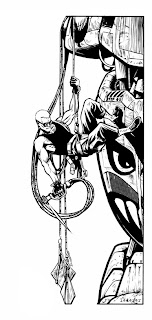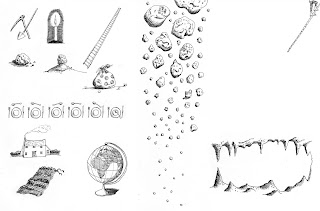Viewing: Blog Posts Tagged with: isolation, Most Recent at Top [Help]
Results 1 - 8 of 8
Blog: Game On! Creating Character Conflict (Login to Add to MyJacketFlap)
JacketFlap tags: conflict, isolation, loneliness, #amwriting, #conflict, #writingtips, #tension, Add a tag
Blog: TWO WRITING TEACHERS (Login to Add to MyJacketFlap)
JacketFlap tags: Trudy Ludwig, quiet kids, teaching positive behavior, bullying, giveaway, mentor texts, isolation, Patrice Barton, Add a tag
The Invisible Boy, a new book that deals with the isolation quiet children can feel, is the kind of book that serves multiple purposes in an elementary school classroom (e.g., interactive read aloud book, teaching demonstration text, mentor text for strategy lessons). Previews of the book and giveaway information come at the bottom of the post.![]()
Blog: studio lolo (Login to Add to MyJacketFlap)
JacketFlap tags: grandmother, cat, isolation, nostalgia, room, blues, studio lolo, laurel gaylord, china pattern, patterned paper, lonliness, Add a tag
Blog: Shrinking Violet Promotions (Login to Add to MyJacketFlap)
JacketFlap tags: coolest introverts in children's literature, solitude, isolation, recharging our batteries, Add a tag
Solitude and isolation; aloneness and loneliness. These are issues that most writers must grapple with at some point in their careers, since writing is usually practiced in solitude. Even the writer who works in a busy cafe or a crowded household has to achieve a bubble of quiet within that space, to enable her to listen to the inner voice.
At first glance, these would appear to be non-issues for the introverted writer, who thrives in solitude. Yet introverts need human connection as well. We are not immune from loneliness; we are not invulnerable to solitude’s darker twin, isolation.
While solitude can be seen as the joyful state of being alone and liking it, isolation is another brand of aloneness. I can think of two kinds of isolation: the first, an aloneness imposed against our will, deprived of company by death or desertion, by the choices of others or by chance and circumstance. Most people recognize this form of isolation: we may have encountered it as “fear of abandonment” or “homesickness” or “mourning” or “the empty nest.” But there is also self-imposed isolation. At its most extreme, we might call this a social phobia. It’s the voice that whispers in our head that it’s just easier to be alone, that people are too unpredictable, relationships are too taxing. We are better off without others. We can go it alone. We don’t have to let anyone else in.
The difference between solitude and isolation is not a matter of quantity: people can be quite happy spending large amounts of time alone, or having a small circle of intimate friends. Rather, it’s a matter of quality. Solitude is an aloneness full of freedom, serenity, a sense of connecting with oneself. It may be joyful or peaceful, stimulating or relaxing. Even some unhappiness expressed in solitude may be healing: we may need time alone to work through our anger at another person, to mourn a loss, to have a good cry. This is still solitude, marked by feeling connected with the inner self.
Isolation, on the other hand, is marked by uneasiness. It may be characterized by numbness, a disconnection with oneself. Addictions often thrive in isolation: compulsive overeating, binge drinking. The aloneness is less a matter of choice than the product of an insidious whisper in the brain: Nobody wants to hear from me. I’m safer alone anyway.
In our society, with its emphasis on social relationships and extroversion, introverts are often assumed to be isolated. But most of the time, our solitude is just our battery-recharging time, the happy and fruitful aloneness we need. Our relationships are characterized more by depth than volume. When disconnection and loneliness arise—which can happen to anyone, introvert or extrovert—it’s important to reach out to those we trust, to break the grip of isolation.
All of us must find the balance that works for ourselves: time alone and time spent with others; time looking inward and time looking outward.
For more discussion of this issue, see Caroline Knapp’s essay, “Time Alone: Navigating the Line Between Solitude and Isolation,” in the collection The Merry Recluse: A Life in Essays, Counterpoint Press, 2004.
~ ~ ~ ~ ~ ~ ~ ~ ~ ~ ~ ~
Jennifer Hubbard is the author of THE SECRET YEAR and longtime Shrinking Violet. She also has impeccable timing. Thank you, Jenn!
Blog: Just One More Book Children's Book Podcast (Login to Add to MyJacketFlap)
JacketFlap tags: review, Podcast, Community, Ages 4-8, Formal, Creativity, Picture book, Friendship, Resilience, childrens book, Boy, Adventure, Life Skills, Cartoony, Visual, Cute, imagination, Thinking/Attitude, moving, Canadian, Contributing/Industry, Co-operation/Collaboration, Dusan Petricic, Gail Herbert, Hazel Hutchins, isolation, Mattland, Canadian, Contributing/Industry, Co-operation/Collaboration, Dusan Petricic, Gail Herbert, Hazel Hutchins, isolation, Mattland, moving, Add a tag
 Author: Hazel Hutchins & Gail Herbert
Author: Hazel Hutchins & Gail Herbert
Illustrator: Dusan Petricic (on JOMB)
Published: 2008 Annick Press (on JOMB)
ISBN: 1554511208 Chapters.ca Amazon.com
More imagination on JOMB:
Tags:childrens book, Dusan Petricic, Gail Herbert, Hazel Hutchins, imagination, isolation, Mattland, moving, Podcast, reviewchildrens book, Dusan Petricic, Gail Herbert, Hazel Hutchins, imagination, isolation, Mattland, moving, Podcast, reviewBlog: Sugar Frosted Goodness (Login to Add to MyJacketFlap)
JacketFlap tags: b/w, Add a tag

This one is from a Star Wars RPG book I worked on roughly 10 years ago as well... Sorry I can't remember which one this came out of either... Again using mostly the same brush and some kind of pen. Anyway, it's fun to dig out this old stuff again.

Viva la ink!
Blog: Picture Bookies Showcase (Login to Add to MyJacketFlap)
JacketFlap tags: pencil, Kathleen Rietz, b/w, Add a tag
Blog: Sugar Frosted Goodness (Login to Add to MyJacketFlap)
JacketFlap tags: drawing, pen and ink, jago, digital inking, jagoillustration, PYBOT, blackandwhite, b/w, Add a tag
Here's what I've been up to recently, drawing a lot of small b/w illos for a series of three Cornish stories... probably best to click on 'em for a larger view.


My website
My blog







It's a lovely calming illustration! It is your world and you have magic in your hands to make it anything you wish; keep looking out to the world. :)
You do so much fun things with paper backgrounds. BTW Elva, who visited me, LOVED your Crow you sent me.
A beautiful illustration, and very beautiful words.
The unused outlet really caught my attention, as that says so much in this day.
I think this is the first time I have read a story you wrote. Fiction I hope unless so big changes have happened in your world! Sweet illustration.
Delicate and lovely illustration.....
Wow this beautiful sad gentle painting
Wow this beautiful sad gentle essay
I'm struck by bab's comment on the outlet. Gosh we have a wonderful community
I hope you write more xoxo
beautiful!!!!
Something to think about and to admire!
Glad you had time to do some art!
Three more nights........
:)
♥M
Oh, L! What a charming sketch and a lovely little story to go with it. Yes, please do not cover that window. We all need a view to expand our horizons.
I wondered if it were the cat talking...or you at an art retreat spot...i am oh so literal...
beautifully drawn...and told.
We all need at least a little window to the world.
So sweet!It's magical:)
Delightful - both story and illustration!
It's wonderful! A beautiful looking painting, and then a story to go with it. I love the simplicity, it has a kind of purity.
Lovely, beautiful shades and patterns!
Beautiful use of color. Like the subtle pattern.
i love this gentle post. beautiful lo. xxx